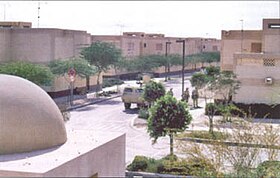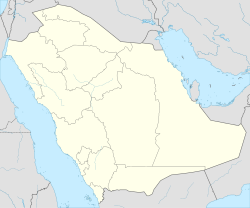Khafji
|
Khafji الخفجي Al Khafji |
|
|---|---|
 |
|
| Coordinates: 28°25′N 48°30′E / 28.417°N 48.500°E | |
| Country |
|
| Emirate | Eastern Province |
| Government | |
| • Monarch and Prime Minister | King Salman |
| • Crown Prince and First Deputy Prime Minister | Mu ammad–ibn Na ef |
| • Deputy Crown Prince and Second Deputy Prime Minister | Prince Mohammed |
| Population (2005) | |
| • Total | 65,000 |
| Time zone | AST (UTC+3) |
| Postal Code | 31971 |
Ras Al Khafji (Arabic: رأس الخفجي Raʾs al-Ḫafğī) or Khafji (الخفجي) is a town on the border between Saudi Arabia and Kuwait. It lies in what was before 1970 the Saudi–Kuwaiti neutral zone. The Japanese-owned Arabian Oil Company Ltd signed a concession agreement with the government of Saudi Arabia in December 1957 and with the government of Kuwait in July 1958 for exploration and development of hydrocarbon reserves in the offshore Neutral Zone. The Arabian Oil Company discovered the Khafji oil field in 1960 and the Hout oil field in 1963.
It was only after the discovery of these oil deposits off-shore of Khafji that a permanent demarcation of the neutral zone between Kuwait and Saudi Arabia was established, with Khafji formally located within Saudi Arabia. However, the agreement concluded that both states would still maintain joint rights to all natural resources within the designated neutral zone. With the termination of the Arabian Oil Company lease to explore and extract within the area, operations within the Khafji Fields reverted to a joint venture between shareholder companies representing both states, with production being split on a 50:50 agreement between Kuwait and Saudi Arabia.
Khafji’s notoriety, however, is primarily owed to the Battle of Khafji, which took place in and around the town in 1991 and marked the high tide of Iraq’s advance through Kuwait and into Saudi Arabia.Khafji's first Prince was Prince Faisal bin Turki I Eldest grandson of the country's Founder Ibn Saud also known as King Abdulaziz.
Al-Khafji largely came into existence following the 1960 discovery of the Al-Khafji oil field. Following the start of commercial oil production, the Arabian Oil Company established a residential compound that was composed of 73 residential quarters, built on a total area of 3,000,000 square feet (280,000 m2), and possessing drainage, electricity, piped water, cable telephones and a road network. The expansion of oil exploration and drilling in the region led the city to gradually expand, generally keeping pace with a trend witnessed throughout the Kingdom.
...
Wikipedia

